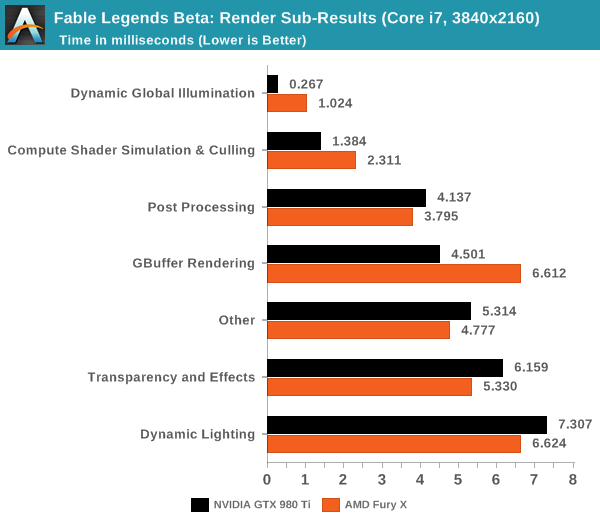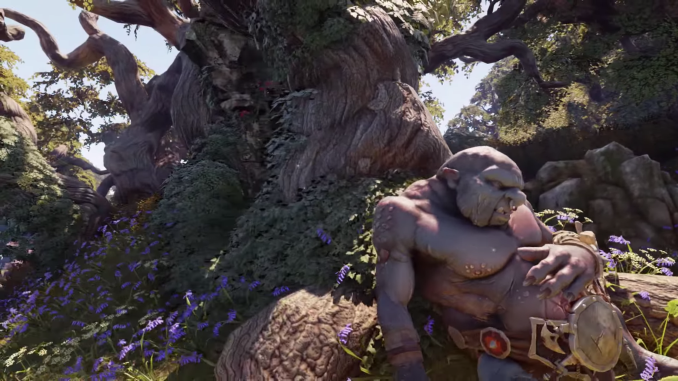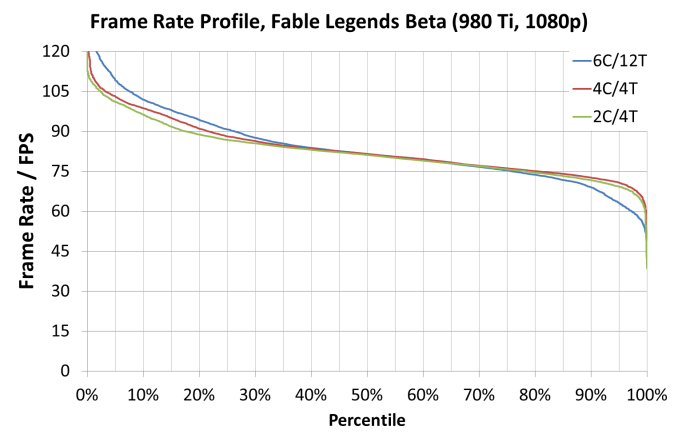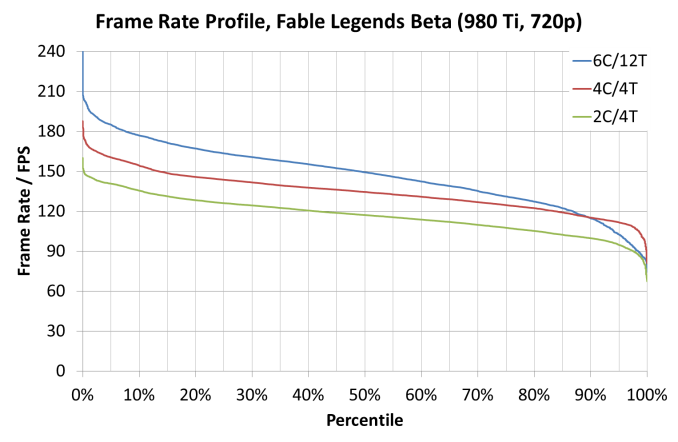Fable Legends Early Preview: DirectX 12 Benchmark Analysis
by Ryan Smith, Ian Cutress & Daniel Williams on September 24, 2015 9:00 AM ESTFinal Words
Non-final benchmarks are a tough element to define. On one hand, they do not show the full range of both performance and graphical enhancements and could be subject to critical rendering paths that cause performance issues. On the other side, they are near-final representations and aspirations of the game developers, with the game engine almost at the point of being comfortable. To say that a preview benchmark is somewhere from 50% to 90% representative of the final product is not much of a bold statement to make in these circumstances, but between those two numbers can be a world of difference.
Fable Legends, developed by Lionhead Studios and published by Microsoft, uses EPIC’s Unreal 4 engine. All the elements of that previous sentence have gravitas in the gaming industry: Fable is a well-known franchise, Lionhead is a successful game developer, Microsoft is Microsoft, and EPIC’s Unreal engines have powered triple-A gaming titles for the best part of two decades. With the right ingredients, therein lies the potential for that melt-in-the-mouth cake as long as the oven is set just right.
Convoluted cake metaphors aside, this article set out to test the new Fable Legends benchmark in DirectX 12. As it stands, the software build we received indicated that the benchmark and game is still in 'early access preview' mode, so improvements may happen down the line. Users are interested in how DX12 games will both perform and scale on different hardware and different settings, and we aimed to fill in some of those blanks today. We used several AMD and NVIDIA GPUs, mainly focusing on NVIDIA’s GTX 980 Ti and AMD’s Fury X, with Core i7-X (six cores with HyperThreading), Core i5 (quad core, no HT) and Core i3 (two cores, HT) system configurations. These two GPUs were also tested at 3840x2160 (4K) with Ultra settings, 1920x1080 with Ultra settings and 1280x720 with low settings.
On pure average frame rate numbers, we saw NVIDIA’s GTX 980 Ti by just under 10% in all configurations except for the 1280x720 settings which gave the Fury X a substantial (10%+ on i5 and i3) lead. Looking at CPU scaling, this showed that scaling only ever really occurred at the 1280x720 settings anyway, with both AMD and NVIDIA showing a 20-25% gain moving from a Core i3 to a Core i7. Some of the older cards showed a smaller 7% improvement over the same test.
Looking through the frame rate profile data, specifically looking for minimum benchmark percentile numbers, we saw an interesting correlation with using a Core i7 (six core, HT) platform and the frame rates on complex frames being beaten by the Core i5 and even the Core i3 setups, despite the fact that during the easier frames to compute the Core i7 performed better. In our graphs, it gave a tilted axis akin to a seesaw:
When comparing the separate compute profile time data provided by the benchmark, it showed that the Core i7 was taking longer for a few of the lighting techniques, perhaps relating to cache or scheduling issues either at the CPU end or the GPU end which was alleviated with fewer cores in the mix. This may come down to a memory controller not being bombarded with higher priority requests causing a shuffle in the data request queue.

When we do a direct comparison for AMD’s Fury X and NVIDIA’s GTX 980 Ti in the render sub-category results for 4K using a Core i7, both AMD and NVIDIA have their strong points in this benchmark. NVIDIA favors illumination, compute shader work and GBuffer rendering where AMD favors post processing, transparency and dynamic lighting.
DirectX 12 is coming in with new effects to make games look better with new features to allow developers to extract performance out of our hardware. Fable Legends uses EPIC’s Unreal Engine 4 with added effects and represents a multi-year effort to develop the engine around DX12's feature set and ultimately improve performance over DX11. With this benchmark we have begun to peek a little in to what actual graphics performance in games might be like, and if DX12 benefits users on low powered CPUs or high-end GPUs more. That being said, there is a good chance that the performance we’ve seen today will change by release due to driver updates and/or optimizing the game code. Nevertheless, at this point it does appear that a reasonably strong card such as the 290X or GTX 970 are needed to get a smooth 1080p experience (at Ultra settings) with this demo.














141 Comments
View All Comments
medi03 - Thursday, September 24, 2015 - link
"AMD had driver with better results, but we didn't use it", "oh, Bryan tested it, but he's away" adds some sauce to it.Oxford Guy - Thursday, September 24, 2015 - link
"we are waiting for a better time to test the Ashes of the Singularity benchmark"L-O-L
Frenetic Pony - Thursday, September 24, 2015 - link
This is as usual a trolley, click bait response. The truth is far more complex than whether one side "wins". Here we can see Amds older card once again benefiting greatly from Dx12, to the point where it clearly pulls ahead of Nvidias similarly priced options. Yet on the high end it seems Nvidia has scaled it's gpu architecture better than Amd has, with the 980ti having the advantage. So, technology, like life, is complicated and not prone to simple quips that accurately reflect reality.jospoortvliet - Friday, September 25, 2015 - link
True. One thing has not changed and becomes more pronounced with DirectX12: AMD offers better performance at every price point.Th-z - Thursday, September 24, 2015 - link
Are you referring to AotS results? That benchmark stresses different things than this classic flyby benchmark, both are useful in their own right. AotS's more akin to real gameplay and stresses draw call capability of DX12, which is *the* highlights of DX12.My question for Ryan, Anandtech didn't test AotS because you said it's still in the early developmental stage, however this one isn't? I say test them all, make interesting before-and-after study cases regardless. Also have you considered improving your comment section?
DoomGuy64 - Friday, September 25, 2015 - link
Incorrect. The $650 Ti is the only Nvidia card better in dx12, and it has 96 ROPs, compared to the Fury's 64, not that Fury is actually doing that bad. AMD on the other hand, is cleaning up with the mid-range cards, which is what most people are buying.masaville888 - Saturday, October 10, 2015 - link
I left AMD for good after too many years of technical issues such as artifacting, poorly optimized drivers and so forth. I always had a good experience with nVidia and after going back I have no regrets. AMD seems more interested in tech announcements than user experience. If they figure out the customer side of things they have the potential to be great, but not until then.lprates - Thursday, October 15, 2015 - link
I totally Agreelprates - Thursday, October 15, 2015 - link
I totally Agreelprates - Sunday, October 18, 2015 - link
I totally Agree